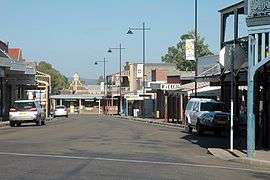Gulgong
| Gulgong New South Wales | |||||||
|---|---|---|---|---|---|---|---|
 Main Street | |||||||
 Gulgong | |||||||
| Coordinates | 32°21′0″S 149°32′0″E / 32.35000°S 149.53333°ECoordinates: 32°21′0″S 149°32′0″E / 32.35000°S 149.53333°E | ||||||
| Population | 1,866 (2011 census)[1] | ||||||
| Postcode(s) | 2852 | ||||||
| Elevation | 475 m (1,558 ft) | ||||||
| Location | |||||||
| LGA(s) | Mid-Western Regional Council | ||||||
| County | Phillip | ||||||
| State electorate(s) | Dubbo | ||||||
| Federal Division(s) | Parkes | ||||||
| |||||||
Gulgong is a 19th-century gold rush town in the Central Tablelands and the wider Central West regions of the Australian state of New South Wales. The town is located about 300 km (190 mi) north west of Sydney, and about 30 km north of Mudgee along the Castlereagh Highway. At the 2011 census, Gulgong had a population of 1,866.[1] It is situated within the Mid-Western Regional Council local government area.
Today, much of the 19th century character of the town remains, contributing to its appeal as a tourist destination. Of special interest is the Prince of Wales Opera House, a survivor with a rich history.[2]
An attraction of note is the Gulgong Pioneer Museum, which has a huge collection of thematically-displayed exhibits, ranging from kitchen utensils to complete buildings that have been relocated to a 'street' on the site. Apart from tourism and hospitality, local industries include wine production, wool, wheat growing and coal mining.
Yarrobil National Park is located 21 kilometres (13 mi) north west of Gulgong.
History
The name 'Gulgong' is derived from the name used by the traditional inhabitants, the Wiradjuri, for 'deep waterhole'. Like several towns in this area, it began as a gold mining centre. However, being founded in the 1870s, it was one of the last to be dominated by 'poor man's diggings', that is by individuals without substantial capital investment.
Novelist and bush poet Henry Lawson lived briefly in Gulgong as a child in the early 1870s, while his father sought instant wealth as a miner. A montage of goldrush-era Gulgong street scenes was used as a backdrop to the portrait of Lawson on the first Australian ten dollar note (which was in use from 1966 until replaced by a polymer banknote in November 1993).[3] The town and its surrounding district feature in Lawson's fiction, especially in Joe Wilson and His Mates.
Gulgong is believed to be one of the primary locations in Thomas Alexander Browne's Robbery under Arms. Australia's first novelist of note, Browne was police magistrate in the period 1871-81. He once hosted English author Anthony Trollope, who later recorded his impressions of Australia and New Zealand (1875).[4]
Railways
Gulgong is at the junction of the Sandy Hollow line (which runs west from Muswellbrook), and the Gwabegar line, (which runs north-south from Gwabegar to Wallerawang). A section of the Gwabegar railway line south of Gulgong to Kandos has been closed since 30 June 2007.
Festival
Gulgong has hosted an international ceramics festival every three years since 1989, most recently over April 17 to 23 2016.[5]
Notable people
- Jimmy Governor, on whom Thomas Kenneally based his character for The Chant of Jimmy Blacksmith, grew up in the Gulgong district and married there in 1898.
- Josh Jackson rugby league player
- Louisa Lawson poet and mother of Henry Lawson
- Colin McKellar Australian senator
Gallery
- Some images of Gulgong NSW

The streets of Gulgong have changed very little since the 19th century 
View from balcony above mechanics workshop 
Mayne St Gulgong 
Typical old commercial buildings in Gulgong 
Prince of Wales Opera House 
Original Gulgong district smithy's house and workshop relocated to 'street' in Gulgong museum 
Local inn, from the 1840s, relocated to museum 'street' 
Interior of the inn 
Horse drawn and motor vehicles in Gulgong museum
References
- 1 2 Australian Bureau of Statistics (31 October 2012). "Gulgong". 2011 Census QuickStats. Retrieved 17 April 2014.
- ↑ Prince of Wales Opera House, Gulgong Archived 22 November 2007 at the Wayback Machine.
- ↑ Museum of Australian Currency Notes: Australia's First Decimal Currency Notes Archived 22 August 2005 at the Wayback Machine.
- ↑ Gulgong - New South Wales - Australia - Travel - smh.com.au
- ↑ Paine, Sam. "Clay festival to be thrown in Gulgong". Mudgee Guardian.
External links
![]() Media related to Gulgong, New South Wales at Wikimedia Commons
Media related to Gulgong, New South Wales at Wikimedia Commons